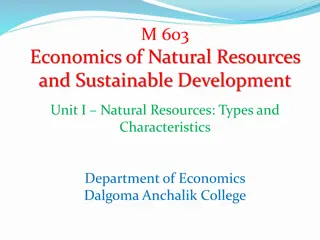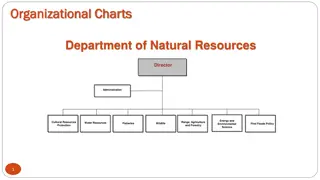
Exploring the Breathtaking Western Ghats: A UNESCO World Heritage Site
The Western Ghats, a UNESCO World Heritage Site in India, is a remarkable mountain range that spans across several states, showcasing rich biodiversity and unique geological formations. Stretching from Gujarat to Kanyakumari, it is a hotspot of biological diversity, housing diverse ecosystems such as tropical forests. This range, with its faulted edges and ancient origins, is a significant natural treasure deserving of exploration and conservation efforts.
Download Presentation

Please find below an Image/Link to download the presentation.
The content on the website is provided AS IS for your information and personal use only. It may not be sold, licensed, or shared on other websites without obtaining consent from the author. If you encounter any issues during the download, it is possible that the publisher has removed the file from their server.
You are allowed to download the files provided on this website for personal or commercial use, subject to the condition that they are used lawfully. All files are the property of their respective owners.
The content on the website is provided AS IS for your information and personal use only. It may not be sold, licensed, or shared on other websites without obtaining consent from the author.
E N D
Presentation Transcript
Topic Natural Resources Presented by Prof. A. S. Mane Department of Environment Science Deogiri College, Aurangabad
Western Ghats Sahyadri Mountains Highest point Anamudi (Eravikulam National Park) 2,695 m (8,842 ft) 10 10 N 77 04 ECoordinates: 10 10 N 77 04 E Dimensions Peak Elevation Coordinates Width- 100 km (62 mi) E W Area- 160,000 km2 (62,000 sq mi)
Geography Country India Ooty, Mahabaleshwar, Madikeri and Munnar Tropical and subtropical moist broadleaf forests Geology Settlements Biome Period Cenozoic Type of rock Basalt and Laterite
UNESCO World Heritage Site Natural Properties - Western Ghats (India) Name as inscribed on the World Heritage List Indiahills.png Country India Type Natural Criteria ix, x Reference 1342 Indian subcontinent UNESCO region Inscription history Inscription 2012 (36th Session)
Introduction The Western Ghats or the Sahy dri constitute a mountain range along the western side of India. It is a UNESCO World Heritage Site and is one of the eight "hottest hotspots" of biological diversity in the world. It is sometimes called the Great Escarpment of India. The range runs north to south along the western edge of the Deccan Plateau, and separates the plateau from a narrow coastal plain, called Konkan, along the Arabian Sea. A total of thirty nine properties including national parks, wildlife sanctuaries and reserve forests were designated as world heritage sites - twenty in Kerala, ten in Karnataka, five in Tamil Nadu and four in Maharashtra.
The range starts near the border of Gujarat and Maharashtra, south of the Tapti river, and runs approximately 1,600 km (990 mi) through the states of Maharashtra, Goa, Karnataka, Tamil Nadu and Kerala ending at Kanyakumari, at the southern tip of India. Western-Ghats-Matheran.jpg
Geology The Western Ghats are not true mountains, but are the faulted edge of the Deccan Plateau. They are believed to have been formed during the break-up of the super continent of Gondwana some 150 million years ago Geophysicists Barron and Harrison from the University of Miami advocate the theory that the west coast of India came into being somewhere around 100 to 80 mya after it broke away from Madagascar. After the break-up, the western coast of India would have appeared as an abrupt cliff some 1,000 m (3,300 ft) in elevation.
Mountains A view of Anamudi, the highest peak of western Ghats 2,695 metres (8,842 ft) from Eravikulam National Park, Kerala. Hill ranges The Western Ghats extend from the Satpura Range in the north, go south past Maharashtra, Goa, through Karnataka and into Kerala and Tamil Nadu. Major gaps in the range are the Goa Gap, between the Maharashtra and Karnataka sections, and the Palghat Gap on the Tamil Nadu and Kerala border between the Nilgiri Hills and the Anaimalai Hills. http://upload.wikimedia.org/wikipedia/commons/thumb/c/ce/Anamudi_1.jpg/300px-Anamudi_1.jpg http://upload.wikimedia.org/wikipedia/commons/thumb/d/dc/Nilgiris_-_Copy.JPG/220px-Nilgiris_-_Copy.JPG 1.Sahydhris hill 2.Nilgiris hill 3.Anaimalai hill 4.Cordamom hill Nilgiris
Peaks Following is a list of some of the highest peaks of the Western Ghats: Rank Name Elevation (m) Location Eravikulam National Park, Kerala 01. Anamudi 2695 Eravikulam National Park, Kerala 02. Meesapulimala 2640 03. Doddabetta 2637 Nilgiris, Tamil Nadu Mukurthi National Park, Tamil Nadu Mukurthi National Park, Tamil Nadu 04. Kolaribetta 2629 05. Mukurthi 2554
Lakes and reservoirs The Western Ghats have several manmade lakes and reservoirs. The well known lakes are the Ooty (2500 m altitude, 34.0 ha) in Nilgiris, and the Kodaikanal (2285 m, 26 ha) and the Berijam in the Palani Hills. The Pookode lake of Wayanad in Kerala at Lakkadi is a beautiful scenic one with boating and garden arrangements. Most of the bigger lakes are situated in the state of Tamil Nadu. Two smaller lakes, the Devikulam (6.0 ha) and the Letchmi Elephant (2.0 ha) are in the Munnar range. http://upload.wikimedia.org/wikipedia/commons/thumb/e/e2/Silent_Valley_National_Park_029.jpg/300px-Silent_Valley_National_Park_029.jpg http://upload.wikimedia.org/wikipedia/commons/thumb/7/7c/Varandha_ghad.jpg/300px-Varandha_ghad.jpg
Rivers The Western Ghats form one of the four watersheds of India, feeding the perennial rivers of India. Important rivers include the Godavari, Krishna and Kaveri. These rivers flow to the east and drain out into the Bay of Bengal. http://upload.wikimedia.org/wikipedia/commons/thumb/4/4f/Westghats_India_Monsoon.jpg/300px-Westghats_India_Monsoon.jpg . Western Ghats in Maharashtra, during the Monsoon The larger tributaries include the Tunga River, Bhadra river, Bhima River, Malaprabha River, Ghataprabha River, Hemavathi river, Kabini River. http://upload.wikimedia.org/wikipedia/commons/thumb/8/80/Jog_Falls%2C_India_-_August_2006.jpg/300px-Jog_Falls%2C_India_-_August_2006.jpg In addition there are several smaller rivers such as the Chittar River, Manimuthar River, Kallayi River, Kundali River and the Pachaiyar River. St spectacular waterfalls in India
Climate http://upload.wikimedia.org/wikipedia/commons/thumb/9/96/Western-Ghats-rainfall.svg/300px-Western-Ghats-rainfall.svg.png Annual rainfall along the Western Ghat region. Climate in the Western Ghats varies with altitudinal gradation and distance from the equator. The climate is humid and tropical in the lower reaches tempered by the proximity to the sea. Elevations of 1,500 m (4,921 ft) and above in the north and 2,000 m (6,562 ft) and above in the south have a more temperate climate. Average annual temperature here are around 15 C (60 F). In some parts frost is common, and temperatures touch the freezing point during the winter months. Mean temperature range from 20 C (68 F) in the south to 24 C (75 F) in the north. It has also been observed that the coldest periods in the south western ghats coincide with the wettest. http://bits.wikimedia.org/static-1.22wmf19/skins/common/images/magnify-clip.png
http://upload.wikimedia.org/wikipedia/commons/thumb/c/c1/Nilgiri_foothills.jpg/300px-Nilgiri_foothills.jpghttp://upload.wikimedia.org/wikipedia/commons/thumb/c/c1/Nilgiri_foothills.jpg/300px-Nilgiri_foothills.jpg Ecoregions The Western Ghats are home to four tropical and subtropical moist broadleaf forest ecoregions the North Western Ghats moist deciduous forests, North Western Ghats montane rain forests, South Western Ghats moist deciduous forests , and South Western Ghats montane rain forests. Nilgiri Hills (Tectona grandis) and Wattle http://upload.wikimedia.org/wikipedia/en/thumb/b/b5/Western_Ghats_RYM.jpg/300px-Western_Ghats_RYM.jpg http://upload.wikimedia.org/wikipedia/commons/thumb/7/70/Mangalore_038.jpg/300px-Mangalore_038.jpg http://bits.wikimedia.org/static-1.22wmf19/skins/common/images/magnify-clip.png Western Ghats near Rajapalayam, Tamil Nadu Western Ghats near Mangalore, Karanataka The Western Ghats are home to four tropical and subtropical moist broadleaf forest ecoregions the North Western Ghats moist deciduous forests, North Western Ghats montane rain forests, South Western Ghats moist deciduous forests, and South Western Ghats montane rain forests.
Biomass protection http://upload.wikimedia.org/wikipedia/commons/thumb/0/0b/Thiruvananthapuram_Ponmudi.jpg/300px-Thiruvananthapuram_Ponmudi.jpg Historically the Western Ghats were well-covered in dense forests that provided wild foods and natural habitats for native tribal people. Its inaccessibility made it difficult f or people from the plains to cultivate the land and build settlements. http://bits.wikimedia.org/static-1.22wmf19/skins/common/images/magnify-clip.png After the arrival of the British in the area, large swathes of territory were cleared for agricultural plantations and timber. The forest in the Western Ghats has been severely fragmented due to human activities, especially clear felling for tea, coffee, and teak plantations during 1860 to 1950. Species that are rare, endemic and habitat specialists are more adversely affected and tend to be lost faster than other species. Complex and species rich habitats like the tropical rainforest are much more adversely affected than other habitats. [21] A view of Ponmudi Hills in Thiruvananthapuram, Kerala http://upload.wikimedia.org/wikipedia/commons/thumb/f/f7/KOvai2.jpg/300px-KOvai2.jpg http://bits.wikimedia.org/static-1.22wmf19/skins/common/images/magnify-clip.png Western Ghats near Coimbatore, Tamil Nadu
UNESCO World Heritage Site In 2006, India applied to the UNESCO MAB for the Western Ghats to be listed as a protected World Heritage Site. In 2012 following 39 places are declared as World Heritage Sites: Kalakkad Mundanthurai Tiger Reserve Shendurney Wildlife Sanctuary Neyyar Wildlife Sanctuary Peppara Wildlife Sanctuary Kulathupuzha Range Palode Range Periyar Tiger Reserve Ranni Forest Division Konni Forest Division Achankovil Forest Division Srivilliputtur Wildlife Sanctuary Tirunelveli (North) Forest Division (part) Eravikulam National Park (and proposed extension) Grass Hills National Park
Fauna The Western Ghats are home to thousands of animal species including at least 325 globally threatened species. Many are endemic species, especially in the amphibian and reptilian classes . Thirty two threatened species of mammals live in the Western Ghats. Of the 16 endemic mammals, 13 are threatened .Mammals-There are at least 139 mammal species . A critically endangered mammal of the Western Ghats is the nocturnal Malabar large-spotted civet. The arboreal Lion-tailed macaque is endangered. Only 2500 of this species are remaining.[3 1] The largest population of Lion tailed macacque is in Silent Valley National Park. Kudremukh National Park also protects a viable population.[ Reptiles- The snake family Uropeltidae of the reptile class is almost entirely restricted to this region. Amphibians- The amphibians of the Western Ghats are diverse and unique, with more than 80% of the 179 amphibian species being endemic to the region. Most of the endemic species have their distribution in the rainforests of these mountains.[36] The endangered Purple frog was discovered in 2003 to be a living fossil. This species of frog is most closely related to species found in the Seychelles. Four new species of Anurans belonging to the genus Rhacophorus, Polypedates, Philautus and Bufo have been described from the Western Ghats. Fish 102 species of fish are listed for the Western Ghats water bodies.[15] Western Ghats streams are home to several brilliantly coloured ornamental fishes like Red line torpedo barb, Red-tailed barb,[38] Osteobrama bakeri, G nther's catfish and freshwater puffer fish Tetraodon travancoricus, Carinotetraodon imitator and marine forms like Chelonodon patoca (Buchanan-Hamilton, 1822);[39] mahseers such as Malabar mahseer. Birds- There are at least 508 bird species. Most of Karnataka's five hundred species of birds[41] are from the Western Ghats region.[42] Bhadra Wildlife Sanctuary is located at the northern end of the Malabar ranges and the southern tip of the Sahyadri ranges and bird species from both ranges can be seen here.
http://upload.wikimedia.org/wikipedia/commons/thumb/7/70/Doppelhornvogel-09.jpg/89px-Doppelhornvogel-09.jpghttp://upload.wikimedia.org/wikipedia/commons/thumb/7/70/Doppelhornvogel-09.jpg/89px-Doppelhornvogel-09.jpg http://upload.wikimedia.org/wikipedia/commons/thumb/6/66/Columba_elphinstonii.jpg/120px-Columba_elphinstonii.jpg http://upload.wikimedia.org/wikipedia/commons/thumb/f/f7/Great-Hornbill.jpg/120px-Great-Hornbill.jpg Great Indian Hornbill Nilgiri Wood- Pigeon Great Hornbill from Valparai http://upload.wikimedia.org/wikipedia/commons/thumb/8/8d/Malabar_Barbet.jpg/120px-Malabar_Barbet.jpg http://upload.wikimedia.org/wikipedia/commons/thumb/6/6f/Golden-Backed_Woodpecker.jpg/120px-Golden-Backed_Woodpecker.jpg Malabar Barbet Golden-Backed Woodpecker http://upload.wikimedia.org/wikipedia/commons/thumb/4/49/Blue-winged_Parakeet.jpg/120px-Blue-winged_Parakeet.jpg http://upload.wikimedia.org/wikipedia/commons/thumb/c/cc/Peacock_parambikulam.JPG/90px-Peacock_parambikulam.JPG http://upload.wikimedia.org/wikipedia/commons/thumb/8/82/Crested_Hawk_E.jpg/120px-Crested_Hawk_E.jpg Blue-winged Parakeet Crested Hawk Eagle Red Whiskered Bulbul
Western Ghats Calling A movement that monitors every moment to stir and sustain a movement.
Appiko movement The Appiko movement was a revolutionary movement based on environmental conservation in India. Deforestation in the Western Ghats The Sahyadri Range, or the Western Ghats, in southern India is the home of a tropical forest ecosystem. Although this tropical forest constitutes a potentially renewable resource, it is also a very fragile ecosystem and therefore merits special attention. The past 30 years have seen the onslaught of "development" activities and an increase in population, both of which have exhausted this fragile resource system. In the case of Kerala, which comprises 42 percent of the entire Western Ghat area, the forest cover fell from 44 percent in 1905 to a meager 9 percent in 1984.
The Movement The Appiko Movement uses various techniques to raise awareness: foot marches in the interior forests, slide shows, folk dances, street plays and so on. The movement has achieved a fair amount of success: the state government has banned felling of green trees in some forest areas; only dead, dying and dry trees are felled to meet local requirements. The movement has spread to the four hill districts of Karnataka Province, and has the potential to spread to the Eastern Ghats in Tamil Nadu Province and to Goa Province.
Save the Western Ghats Movement The Save the Western Ghats Movement (SWGM) was a landmark event in environmental activism in India. It was one of the first of its kind in the country and became the model for numerous campaigns all over India. In October 1986, PS organised a national consultation on environment, during which it was decided to organize a march along the entire length of the Western Ghats, to focus attention on the urgent need to halt the process of degradation that was threatening to create irremediable damage to the entire area. The goal was to create an integrated Ecological perspective providing for both environmental protection as well as the rights of the rural communities. Later, Peaceful Society was appointed the Coordinating Agency of the entire event as Central Coordinator. Organizational Structure
Through this gathering a conscious effort will be made to make the participants, supporters and enthusiasts commit for responsible action to Save the one and only Western Ghats. Western Ghats are under threat and civil society is constantly addressing the these issues through action, advocacy and lobbying. Save the Western Ghats March of 1987-88 is a unique event that created history. It marked the beginning to bring the civil society to work for the cause of sustainable development . It tried for the first time the landscape level thinking across the political boundaries.It started mainstreaming Western Ghats.






















